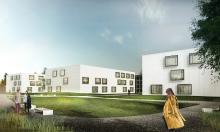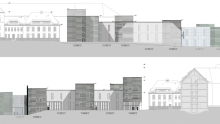Clemens-Winkler-Bau
Bedarfsgerechte Unterbringung Laborkonzept Stufe 1 – Sanierung Altbau
Das bestimmende Gebäude des Campus Süd ist der Clemens-Winkler-Bau mit seinem auf der Ostseite angegliederten Hörsaalanbau. Das südwestlich der Leipziger Straße gelegene Gebäudeensemble beherbergt die Fakultät für Chemie und Physik.
Der Clemens-Winkler-Bau ist ein Leitbau für die Campusbebauung und steht unter Denkmalschutz. Es ist geplant, dieses aus den 50er Jahren stammende Gebäude zu sanieren. Als erste Maßnahme wurde bereits in den Jahren 2012-14 ein Ersatzneubau für die Praktikumslabore an der Leipziger Straße errichtet. Ziel waren der Freizug und der Abriss des Westflügels, das zwischenzeitlich erfolgt ist. Als weitere Maßnahme wurde die Errichtung zweier weiterer Neubauten (Neubau Laborflügel Mitte und Neubau Laborflügel Süd) vollzogen.
Dritter und letzter Abschnitt ist nun die Sanierung des Hauptgebäudes mit dem Ziel der optimalen Unterbringung der benötigten Büro-, Lehr- und Lagerflächen. Dazu wird das Gebäude in seiner Grundstruktur erhalten und an die geänderten Nutzungsanforderungen angepasst. Durch die Sanierung entstehen 4.596 m² Hauptnutzfläche.

Clemens-Winkler-Bau - Needs-based accommodation | Laboratory concept stage 1 - New construction of the center and south laboratory wings
The construction project is planned on the TU Bergakademie Freiberg campus site, which is located to the northwest of the city center. The dominant building in this area is the Clemens-Winkler-Bau from the 1950s and 1960s, which is used by the Faculty of Chemistry and Physics. This is a landmark building for the campus development and is a listed building.
The first measure was the construction of the north laboratory wing in 2012-14 as a replacement building for the practical laboratories on Leipziger Straße. The construction of two further new buildings connected to the old building and the renovation of the old Clemens-Winkler-Bau building are planned as further measures.
The aim of the new central and south laboratory wings on the west side of the Clemens-Winkler-Bau building is to provide optimal accommodation for the required laboratories, workshops, and storage areas. The two additional laboratory wings will create approx. 4,500 m² of main usable space for various uses with the integration of S2 laboratories and clean room areas.
The other areas required will be accommodated in a further construction phase after the completion of the new laboratory wing buildings with the renovation of the existing building in the Clemens-Winkler-Bau main building.
Construction period: 2017-2023 (new laboratory wing buildings)

Faculty of Mechanical, Process and Energy Engineering | Centre for Process and Mechanical Engineering | New hall complex, 2nd construction phase
This measure will expand the existing technical centre for machine and process development on Lampadiusstrasse by two additional test halls and three further technical centre blocks.
The Institutes of Machine Elements, Design and Production (MEKF), Mechanical Engineering (UUMA), Mechanical Process Engineering and Processing Technology (MVTAT), Ceramics, Glass and Building Materials Technology (KGBT) and Thermal Process Engineering, Environmental and Natural Materials Process Engineering (ITUN) will receive urgently needed laboratory and technical centre areas to replace the worn-out ones in the existing Karl Kegel and Erich Rammler buildings.
Examinations of the existing buildings showed that a modern laboratory infrastructure in historical buildings is neither economically viable nor does the technical implementation seem feasible due to the large number of complex boundary conditions.
While the Faculty of Mechanical, Process and Energy Engineering already received modern technical centre areas for general mechanical engineering in 2011 with the first construction phase of the hall complex, the higher-equipped areas for process engineering are now to follow with this measure. The research activities of future users will thus be significantly strengthened, as application-oriented research in particular requires the translation of the laboratory scale into industrial or semi-industrial sizes.
Construction period: 2020-2023